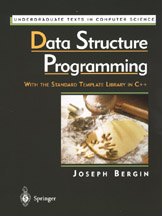 Click
to see larger version of cover
Click
to see larger version of cover Click
to see larger version of cover
Click
to see larger version of cover
Files for the book are here. They are NOT guaranteed to be bug free. Some of them were left in an incomplete state.
The book was written before the standard was finalized. To see how to use the book (and the STL) with the final version of the standard look here.
The first printing has a few errors. Here is the errata sheet.
The following table of contents represents the current state of the work.
It will be updated from time to time as progress is made.
Joseph Bergin
November, 1996
Chapter 3. Overview of Container Mechanisms.
3.1 Storage Mechanisms
3.2 Dense Storage
3.3 An Extended Example Part 1: The Array Stack
3.4 Linked Storage
3.5 An Extended Example Part 2: The Linked Stack
3.6 Tree Storage and Graph Storage
3.7 Hashed Storage
3.8 Summary
3.9 Exercises
Chapter 4. Overview of the Standard Template Library.
4.1. Components of the STL
4.2 A Motovating Example: A Spelling Checker
4.3 Containers
4.3.1 Sequence Containers
4.3.2 More on the Spell Checker
4.3.3 Sorted Associative Containers
4.3.4 Rebuilding the Spelling Dictionary as a Set
4.4 Iterators
4.4.1 Forward Iterators
4.4.2 Bidirectional Iterators
4.4.3 Random Access Iterators
4.4.4 Input Iterators
4.4.5 Output Iterators
4.4.6 Istream and Ostream Iterators
4.5 Generic Algorithms
4.5.1. Minimum and Maximum Algorithms.
4.5.2. Generalized Numeric Algorithms
4.5.3 Nonmutating Sequence Operations
4.5.4 Mutating Sequence Operations
4.5.5 Sorting Related Operations
4.5.6 Set Operations on Sorted Structures
4.5.7 Heap Operations
4.5.9 Permutation Generation Operations
4.5.10 Miscelaneous Additional Operations
4.6 Function Objects
4.6.1 Arithmetic Operations
4.6.2 Comparison Operations
4.6.3 Logical Operations
4.7 Adaptors
4.7.1. Function Adaptors
4.7.2 Container Adaptors
4.7.2.1 Stack Adaptor
4.7.2.2 Queue Adaptor
4.7.2.3 Priority Queue Adaptor
4.7.3 Iterator Adaptors.
4.7.3.1 Reverse Iterators
4.7.3.2 Insert Iterators
4.8 Allocators
4.9 Summary
4.10 Exercises
Chapter 5. Vector Programming.
5.1. Vectors -- Expandable Arrays
5.2 The Indexing Problem
5.3 How We Can Implement Vectors
5.4 Memory Management
5.5 Adding to the Functionality of ExpandableArrays
5.6 Programming with expandable arrays
5.7 Building a Stack Adaptor
5.9 A Graph Implemented with STL vectors
5.11 Summary
5.12 Exercises
Chapter 6. DEQueue Programming.
6.1. Queues and Double Ended Queues
6.2 Implementing a DEQueue.
6.3 A Simple deque Example
6.4 The deque Interface
6.5 Efficiency of deques
6.6 More on Container Adaptors -- The queue Adaptor
6.7 Priority Queues and Heaps
6.7.1 Heaps
6.7.2 Priority Queues
6.8 STL Generic Algorithms--Searching and Sorting
6.8.1 Generalized Searching
6.8.2 Sorting
6.8.3 Searching Sorted Containers
6.9 Median and Other Order Statistics
6.10 Merging
6.11 Summary
6.12 Exercises
Chapter 7. List Programming.
7.1. Implementation Strategies of STL Lists
7.2. Properties of STL Lists.
7.3 A Simple Implementaton of Circular Lists
7.3.1 Sorting a List
7.3.2 Recursive List Operations
7.3.3 Some Difficulties with this Implementation
7.4 An Alternate Implementation of Lists
7.5 The Iterator Invalidation Problem and its Solution
7.6 Techniques for Lists
7.6.1 Finding an Item in a Sorted List
7.6.2 Inserting Into a Sorted List
7.6.3 Applying an Arbitrary Function to Each Element of a List.
7.6.4 Splicing Lists
7.6.5 Merging Sorted Lists
7.6.6 Reversing a List
7.6.7 Building a Spelling Dictionary
7.6.8 A Merge Sort Suitable for Lists
7.7 Summary
7.8 Exercises
Chapter 8. Set and Map Programming.
8.1. Sequential versus Sorted Containers
8.2 Binary Trees
8.3 Binary Search Trees
8.4 Balanced Binary Search Trees
8.5 2-3-4 Trees
8.6 Red Black Trees
8.7 Sets and Multisets
8.8 Maps and Multimaps
8.9 An Implementation of Red-Black Trees
8.10 Summary
8.11 Exercises
Chapter 9. Heap Programming.
9.1. Hashed Associative Containers and the STL
9.2 Simple Hashing--Separate Chaining
9.3 Simple Hashing--Circular Hashing
9.4 Variations on Simple Hashing
9.5 Hash Functions
9.6 Reorgainzation of a Hash Table
9.7 Using Hashed Structures
9.8 Elements of an Implementation
9.9 Design Issues
9.10 Extending The Standard Template Library
9.11 Summary
9.12 Exercises
Appendix. STL Summary.
A.1 Algorithms prototypes
A.1.1. Maximum and Minimum
A.1.2. Generalized Numeric Operations
A.1.3 Nonmutating Sequence Operations
A.1.4 Mutating Sequence Operations
A.1.5. Sorting Related Operations
A.1.6. Set Operations on Sorted Structures
A.1.7. Heap Operations
A.1.8. Lexicographical Compare Operations
A.1.9. Permutation Generator Operations
A.1.10. Miscelaneous Operations
A.2 Containers
A.2.1 Sequential Containers
A.2.2 Sorted Associative Containers
A.3 Adaptors
A.3.1 Container Adaptors
A.3.1.1 Stack Adaptor
A.3.1.2 Queue Adaptor
A.3.1.3 Priority Queue Adaptor